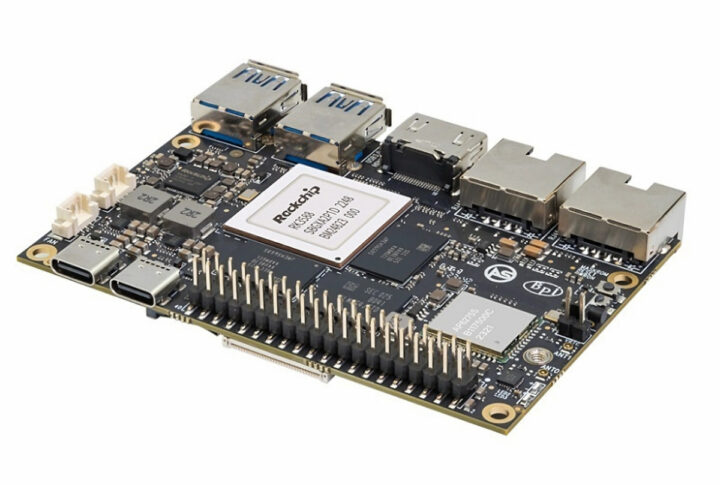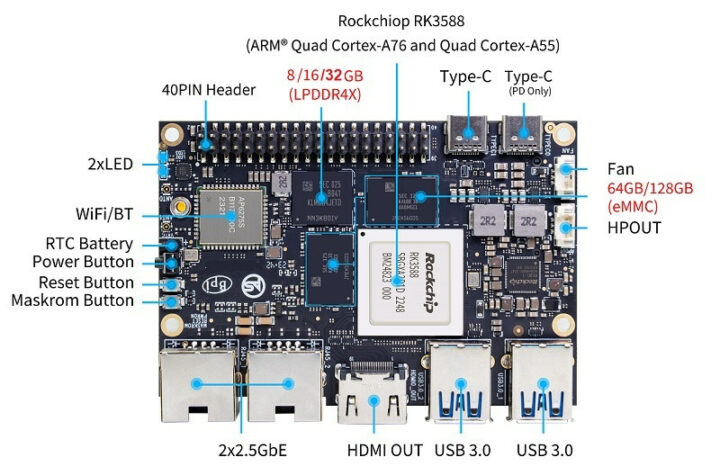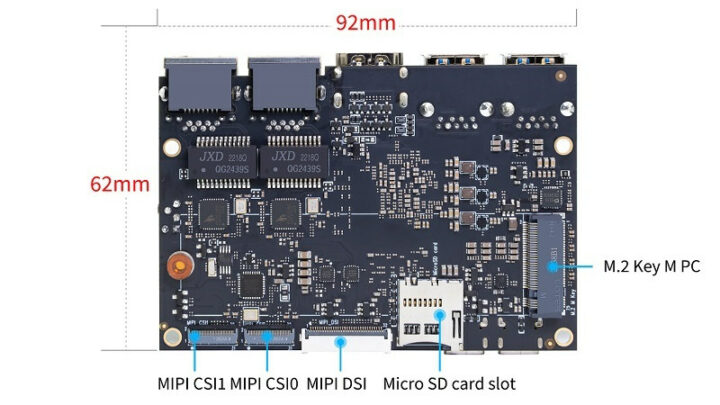Banana Pi BPI-M7 SBC is powered by a Rockchip RK3588 SoC and comes with a low profile design that reminds me of boards from Khadas such as the Khadas Edge2 or VIM4 SBCs but with a few extra ports thanks to the larger form factor.
The Banana Pi BPI-M7 single board computer is equipped with up to 32GB RAM and 128GB eMMC flash and features an M.2 2280 socket for one NVMe SSD, three display interfaces (HDMI, USB-C, MIPI DSI), two camera connectors, dual 2.5GbE, WiFi 6 and Bluetooth 5.2, a few USB ports, and a 40-pin GPIO header for expansion.
Banana Pi BPI-M7 specifications:
- SoC – Rockchip RK3588 octa-core processor with
- System Memory – 8GB, 16GB, or 32GB LPDDR4x
- Storage
- 64GB or 128GB eMMC flash
- M.2 Key-M 2280 (PCIe 3.0 x4) socket for NVMe SSD
- MicroSD card slot
- Video Output
- 1x HDMI 2.1 port up to 8Kp60
- 1x USB-C port with DisplayPort Alt mode up to 8Kp30
- 1x MIPI DSI port up to 4Kp60
- Camera I/F – 2x MIPI CSI camera connectors
- Audio – Speaker connector
- Networking
- 2x 2.5 GbE RJ45 ports
- WiFi 6 and Bluetooth 5.2 via AP6275S module
- USB – 2x USB 3.0 ports, 1x USB Type-C port
- Expansion
- 40-pin Raspberry Pi-compatible header
- M.2 Key-M 2280 (PCIe 3.0 x4) socket
- Misc – Power push button, Reset and MaskROM buttons, 2x LEDs, Fan header, 2-pin RTC battery header
- Power Supply – Via USB-C PD port
- Dimensions – 92 x 62 mm allegedly following the Pico-ITX form factor but that’s supposed to be 100 x 72 mm…
Banana Pi officially provides Debian 11 and Android 12 images based on Linux 5.10 for the board as well as support for the Buildroot build system. Third-party images from Armbian (Ubuntu 20.04 Ubuntu 22.04) and Kylin OS are also said to be available. But note that the wiki does not provide any link for images at the time of writing despite the board being for sale…
What we do get are links to the kernel and u-boot repositories on GitHub. Note those are hosted under the ArmSom account, and the Banana Pi BPi-M7 is also known as the ArmSom Sige7 and the company does provide some work-in-progress documentation and links to firmware images and development tools on Google Drive.
Banana Pi has now started taking orders for the BPI-M7 for $165 plus shipping on Aliexpress in 8GB/64GB configuration. It’s not the first Rockchip RK3588 from the company – see BPI-RK3588 and BPI-W3 – and one can hope software support is better than in the past since Rockchip RK3588 has been around for a few years.
Updated: This post was initially published on November 22, 2023 and updated following the launch of the Banana Pi BPI-M7 on Aliexpress

Jean-Luc started CNX Software in 2010 as a part-time endeavor, before quitting his job as a software engineering manager, and starting to write daily news, and reviews full time later in 2011.
Support CNX Software! Donate via cryptocurrencies, become a Patron on Patreon, or purchase goods on Amazon or Aliexpress. We also use affiliate links in articles to earn commissions if you make a purchase after clicking on those links.







If i will be able to run RHEL/AlmaLinux/RockLinux 9 on that eMMC, i’ll consider getting this if price is reasonable.
My use case would be to use M.2 M-key SATA adapter to add 2 SATA SSDs for NAS or Ceph cluster
Check out the friendlyelec CM3588 with its NAS carrier board, that has slots for 4 NVMe SSDs built in. I’m using one now for Plex and it seems like a good package.
For once, the connector layout is really nice !
I agree. However the cooling will require a specific heatsink that’s the size of the board, or which will be the top of the enclosure itself, because there are no dedicated holes to attach one.
In this case, not supplying for a longer period of time will allow the company to watch the progress of RK3588, especially with better and required kernel support, giving them the potential option of pulling the plug if the SOC turns out to be somewhat of a Turkey/lemon.
“Rockchiop” misspelling in the first board layout image. Anyway, I like the all long-side front and back facing I/O
I love this!
I want it.
You should have a look at other boards with the same chip: https://www.cnx-software.com/page/3/?s=rk3588
A pretty similar one is the NanoPC-T6 which has a somewhat comparable ports disposition, plus the fixation for a heatsink and even a metal enclosure that serves as a passive heatsink. The OrangePi 5 Plus is very similar with a more compact board and no enclosure.
Same borked 5.10 kernel from rockchip?
This is still the bottleneck for RK3588 development and getting the best from the SOC. We are now more than 13 months since release and in danger of looking like a lemon, like the RK3399 before it. The RPI5, with less powerful SOC has steamed ahead in no time with lightning fast development.
Right now RK3588 is looking more like Edsel.
Another point is that RK probably messed up a bit with the chip design: if their A76 in 12nm have difficulties crossing the 2.2 GHz barrier while Broadcom’s A76 at 16nm sells at 2.4 stock and reaches 3.0 GHz overclocked, there’s definitely something wrong on RK’s side that they need to figure and fix.
Then for the price, the NanoPC-T6 from FriendlyELEC is a much better deal: $129 in a similar configuration with better port disposition (+ 32MB SPI NOR included for the boot loader and that is missing here). And for the same price (well $167) you also have the metal enclosure.
The only feature that is missing from the NanoPC is the 32GB option. All the rest is better.
And best part of the nanopc-t6 – it’s no bananaware!
of course 🙂
> The only feature that is missing from the NanoPC is the 32GB option.
That’s too bad … I really need 32GB RAM for my use case 🙁
I asked them already about that option, I even posted such a question on their site, and another one asked for it as well. I insisted that such a powerful board will likely be running many services. And in my case I’d really like to experiment with some LLMs on it. I guess that if other people ask them about 32GB they’ll start to consider it 🙂
Mixtile sent us a Blade 3 board with 32GB RAM for testing LLMs.
Right now they can only run on the GPU, but Rockchip is working on NPU support that will be significantly faster.
Yep, I’ve seen that some people tried to make use of their crappy closed-source RKNN or rknpuv2 or I don’t remember what and didn’t manage to implement it in LLMs due to API shortages. It would be so much easier if they just provided very low level macros to directly access instructions or batch data transformations. Also this disease consisting in making libs for use with python is particularly irritating when you see the amount of resources it requires to use the same model! It’s between 2 and 6 times more RAM for the same thing from what I’ve tested, not counting the amazingly long time it takes for the program to start! I’m fine with students using this to experiment and discover but you can definitely nor run inferences on that on SBCs, or you’re dedicating your board to that resource waster instead of the target job.
[ while NPU’s are significantly lower power requirement (on consumer SoCs and suitable parallelizing) with LLMs prepared, cpu part is mostly no limitation for most tasks on consumer side(?) and mainlining gpu’s is (thanks to open source and reverse engineering through knowledgeable volunteers) available for even small(er) vendors (ARM on linux/bsd?) with limited capacity for software adjustments(?) yes&no ]
I’ve tried a little bit to see what was possible to do with opencl which looks relatively good on 3588, but apparently it’s not usable for everything. Also I suspect that the memory speed will remain very low for most use cases. Dual-64 bit is not terrible compared to what’s available on faster machines or external graphics cards.
[ it could be interesting what are sales numbers for 3588/32GB devices and what is average utilized share of ram; guess would be lower than (mostly) ~25% (on arm64, wrt to software preferences, vs. games(?) maybe ) and thinking about ‘next’ devices, too(?), including nvme including dram(?) on pcie3 (or maybe v4) ]
The number of sales of RK3588 boards with 32GB RAM must be pretty low. We asked for Orange Pi for one for testing, and they told us they won’t sell those anymore.
Mixtile sent us a Blade 3 sample with 32GB RAM because they have some customers who need those. But they are making clusters so it might be why.
[ Thanks for the insight.
maybe it requires additional options (since soldered has advantages for e.g. automotive applications) for ram for consumers(?) with people thinking about LPDDR5 already, and offering high memory capacities
https://www.cnx-software.com/2023/09/29/samsung-lpcamm-integrates-lpddr-ram-on-removable-modules/ (?) ]
I think the main issue is the price of higher-capacity memory chips, so it’s cheaper to go with Intel platforms.
[ (Yes, Thanks, and in advance)
it would be interesting reading about Your point of view for a comparison pros&cons for aarch64 | risc-v (e.g. ‘https://riscv.org/blog/2024/01/the-rise-of-risc-v-analyzing-market-trends-and-ecosystem-dynamics/ ‘) | x86_64 with summing up options on ‘cpu’/SoC&performance&cost&peripherals&software&energy&security(|vendor/platform lock-in), including comments enhancing POV for usage&expectations with SBCs(?) ]
Still boring board.
Do you guys know why there is no RK3588/RK3588S board with LPDDR5 RAM on the market?
probably the price, maybe the availability of chips with 16-bit channels, or routing difficulties caused by increased frequency ?
Really interested in power measurements for the 32GB RAM version, specially in idle.
What would be a good SBC with a decent NPU that are “fully” open source, firmware-wise at the current moment? Is there any? Getting this rockchip looks like endless suffering.
Libre Computer AML-311D-CC “Alta: would be a good option, and Khadas VIM3 might do too. Both have a 5 TOPS NPU supported by an open-source driver. It is a bit slower than the closed-source one though. See the article below for details.
https://www.cnx-software.com/2024/01/25/vivante-npu-amlogic-a311d-open-source-driver-mesa/
Thanks so much Jean-Luc for the prompt suggestion!